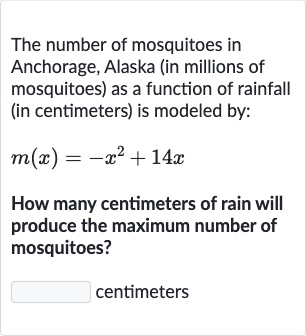Full solution
Q. The number of mosquitoes in Anchorage, Alaska (in millions of mosquitoes) as a function of rainfall (in centimeters) is modeled by:How many centimeters of rain will produce the maximum number of mosquitoes?
- Given quadratic function: We are given the quadratic function , which models the number of mosquitoes (in millions) as a function of rainfall (in centimeters). To find the number of centimeters of rain that will produce the maximum number of mosquitoes, we need to find the vertex of the parabola represented by this quadratic function. The -coordinate of the vertex will give us the amount of rainfall that maximizes the number of mosquitoes.
- Calculating the value of h: The vertex of a parabola given by the function is at the point , where . In our case, and . Let's calculate the value of h.
- Rainfall that maximizes mosquitoes: The value of centimeters represents the amount of rainfall that will produce the maximum number of mosquitoes according to the model .
More problems from Solve quadratic equations: word problems
QuestionGet tutor help
QuestionGet tutor help
QuestionGet tutor help
QuestionGet tutor help
QuestionGet tutor help
QuestionGet tutor help
QuestionGet tutor help
QuestionGet tutor help

